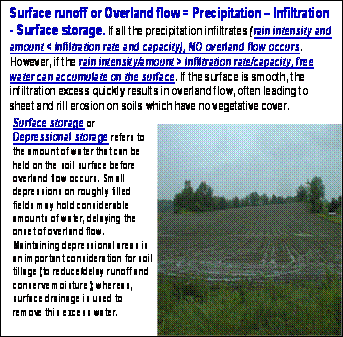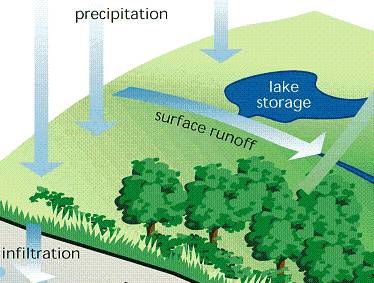Competency Area 2: Soil hydrology AEM
PO 11. Understand factors that affect:
- Soil Infiltration
- Evaporation and Transpiration
- Leaching
- Runoff
- Soil Water Storage
Runoff
Surface runoff or overland flow occurs when the soil cannot infiltrate water fast enough or when infiltration ceases, and there is no further capacity to store the water near the soil surface. When the rain intensity is greater than the soils infiltration rate, the excess free water accumulates at the soil surface. This infiltration-excess may quickly result in overland flow if there is no vegetation or surface depressions that help store it, and the soil surface is sloped. A vegetative cover on the soil is very important to intercepting and dispersing the raindrop impact energy of high intensity rainfall events and in slowing the movement of overland flow when it occurs, but a thick vegetation mat or sod thatch can also provide some water storage.


Illustration by Tom Schultz Courtesy of Iowa State University Department of Natural Resource Ecology and Management http://www.h2owell.com/hydro_cycle_pic.htm
Surface storage or depressional storage refers to the amount of water that can be held on the soil surface before overland flow occurs, and small depressions on roughly tilled fields may hold considerable amounts of water, delaying the onset of overland flow. Infiltration-excess runoff depends on the soil's infiltration rate, and may occur anywhere in the landscape where soils with low infiltrability occur. Infiltration-excess type runoff rarely occurs on the coarser textured soils or in soils with extensive macropore development.
When the amount of rainfall is greater than the cumulative infiltration capacity of the soil, infiltration ceases and the excess free water accumulates at the soil surface as a result of saturation-excess. Soils with shallow impermeable layers or poorly drained soils where water tables are close to the surface have limited cumulative infiltration capacity, and are thus quickly vulnerable to saturation-excess runoff. Saturation-excess runoff is not sensitive to rain intensity or soil type (infiltration rate), but depends on where the saturated areas occur in the landscape.
Water that infiltrates and is in excess of the soils available water holding capacity is subject to seepage flow or groundwater runoff. In flat landscapes this excess water causes a rise in the water table, saturates the soil and this saturation-excess recharges and fills streams, or eventually leads to flooding conditions. In sloping landscapes, the excess deep percolation also raises water tables, concentrating the water to lower portions of the landscape and recharging streams. In sloping landscapes where the subsoil is comprised of layers which conduct water at different rates, interflow above the lesser conductive layers redistributes water laterally to lower parts of the landscape, saturating low lying areas and in some situations producing springs.

Quick Links
- Competency Area 1: Basic soil properties
- Competency Area 2: Soil hydrology AEM
- Competency Area 3: Drainage and irrigation AEM
- Competency Area 4: Soil health and compaction
- Competency Area 5: Soil conservation AEM
- Competency Area 6: Watershed hydrology AEM
- Competency Area 7: Non-point source pollution AEM
- Competency Area 8: Concentrated source pollution AEM
- Competency Area 9: Conservation planning AEM
